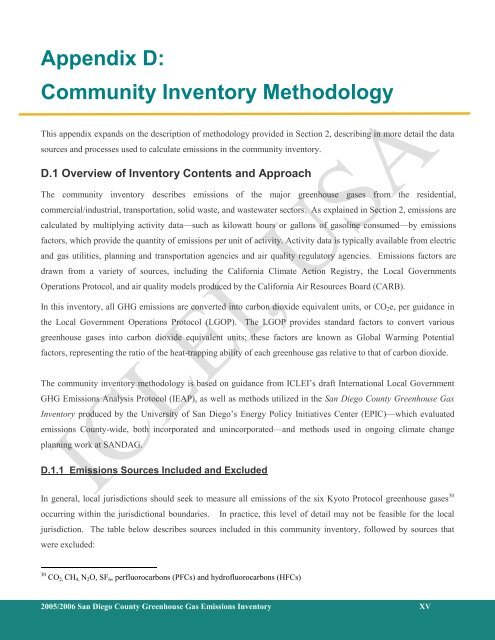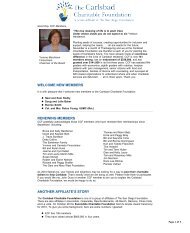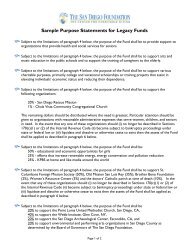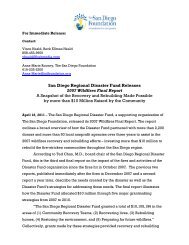County of San Diego 2005/2006 Greenhouse Gas Emissions Inventory
County of San Diego 2005/2006 Greenhouse Gas Emissions Inventory
County of San Diego 2005/2006 Greenhouse Gas Emissions Inventory
You also want an ePaper? Increase the reach of your titles
YUMPU automatically turns print PDFs into web optimized ePapers that Google loves.
Appendix D:<br />
Community <strong>Inventory</strong> Methodology<br />
This appendix expands on the description <strong>of</strong> methodology provided in Section 2, describing in more detail the data<br />
sources and processes used to calculate emissions in the community inventory.<br />
D.1 Overview <strong>of</strong> <strong>Inventory</strong> Contents and Approach<br />
The community inventory describes emissions <strong>of</strong> the major greenhouse gases from the residential,<br />
commercial/industrial, transportation, solid waste, and wastewater sectors. As explained in Section 2, emissions are<br />
calculated by multiplying activity data—such as kilowatt hours or gallons <strong>of</strong> gasoline consumed—by emissions<br />
factors, which provide the quantity <strong>of</strong> emissions per unit <strong>of</strong> activity. Activity data is typically available from electric<br />
and gas utilities, planning and transportation agencies and air quality regulatory agencies. <strong>Emissions</strong> factors are<br />
drawn from a variety <strong>of</strong> sources, including the California Climate Action Registry, the Local Governments<br />
Operations Protocol, and air quality models produced by the California Air Resources Board (CARB).<br />
In this inventory, all GHG emissions are converted into carbon dioxide equivalent units, or CO 2 e, per guidance in<br />
the Local Government Operations Protocol (LGOP). The LGOP provides standard factors to convert various<br />
greenhouse gases into carbon dioxide equivalent units; these factors are known as Global Warming Potential<br />
factors, representing the ratio <strong>of</strong> the heat-trapping ability <strong>of</strong> each greenhouse gas relative to that <strong>of</strong> carbon dioxide.<br />
The community inventory methodology is based on guidance from ICLEI’s draft International Local Government<br />
GHG <strong>Emissions</strong> Analysis Protocol (IEAP), as well as methods utilized in the <strong>San</strong> <strong>Diego</strong> <strong>County</strong> <strong>Greenhouse</strong> <strong>Gas</strong><br />
<strong>Inventory</strong> produced by the University <strong>of</strong> <strong>San</strong> <strong>Diego</strong>’s Energy Policy Initiatives Center (EPIC)—which evaluated<br />
emissions <strong>County</strong>-wide, both incorporated and unincorporated—and methods used in ongoing climate change<br />
planning work at SANDAG.<br />
D.1.1 <strong>Emissions</strong> Sources Included and Excluded<br />
In general, local jurisdictions should seek to measure all emissions <strong>of</strong> the six Kyoto Protocol greenhouse gases 30<br />
occurring within the jurisdictional boundaries. In practice, this level <strong>of</strong> detail may not be feasible for the local<br />
jurisdiction. The table below describes sources included in this community inventory, followed by sources that<br />
were excluded:<br />
30 CO 2, CH 4, N 2 O, SF 6 , perfluorocarbons (PFCs) and hydr<strong>of</strong>luorocarbons (HFCs)<br />
<strong>2005</strong>/<strong>2006</strong> <strong>San</strong> <strong>Diego</strong> <strong>County</strong> <strong>Greenhouse</strong> <strong>Gas</strong> <strong>Emissions</strong> <strong>Inventory</strong> XV
















